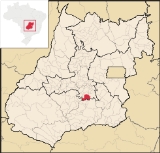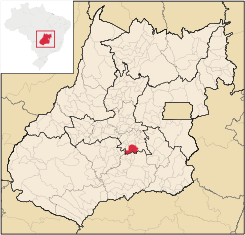
Hidrolândia
Encyclopedia
| Hidrolândia | |
|---|---|
| State | Goiás Goiás Goiás is a state of Brazil, located in the central part of the country. The name Goiás comes from the name of an indigenous community... |
| Area: | 944.2 km² |
| Population: | 14,004 (IBGE 2007) |
| Elevation: | 814 m above sea level |
| Postcode (CEP): | 75340-000 |
| Became a city: | 1958 |
| Distance to Goiânia Goiânia -Climate:The city has a tropical wet and dry climate with an average temperature of . There's a wet season, from October to April, and a dry one, from May to September. Annual rainfall is around 1,520 mm.... : |
36 km. |
| IBGE statistical microregion: | Goiânia Microregion Goiânia Microregion The Goiânia Microregion is a region in central Goiás state, Brazil. It includes 17 municipalities with a population of 2,032,305 in a total area of 6,848.00 km².... |
| Website: | none |

Municipality
A municipality is essentially an urban administrative division having corporate status and usually powers of self-government. It can also be used to mean the governing body of a municipality. A municipality is a general-purpose administrative subdivision, as opposed to a special-purpose district...
in central Goiás
Goiás
Goiás is a state of Brazil, located in the central part of the country. The name Goiás comes from the name of an indigenous community...
state, Brazil
Brazil
Brazil , officially the Federative Republic of Brazil , is the largest country in South America. It is the world's fifth largest country, both by geographical area and by population with over 192 million people...
. The population was 14,004 (2007) in a total area of 944.2 km² (10/10/2002). Hidrolândia is a large producer of poultry and eggs.
Location
Hidrolândia is located 36 km. south of the state capital, GoiâniaGoiânia
-Climate:The city has a tropical wet and dry climate with an average temperature of . There's a wet season, from October to April, and a dry one, from May to September. Annual rainfall is around 1,520 mm....
on important interstate highway BR-153. It belongs to the Goiânia Microregion
Goiânia Microregion
The Goiânia Microregion is a region in central Goiás state, Brazil. It includes 17 municipalities with a population of 2,032,305 in a total area of 6,848.00 km²....
, which contains more than one million seven hundred thousand inhabitants.
Considered the capital of the jaboticaba (a blackish tropical fruit—Myrciaria cauliflora) See Jaboticaba because of the great quantity of jaboticaba trees in the region, Hidrolândia is also known as the city of waters. The concentration of springs, bathing spots and rivers in the area gave the city this name.
History
Hidrolândia began in 1895 when lands were donated to build a chapel dedicated to Santo Antônio. In 1896 it was elevated to a district with the name Santo Antônio das Grimpas belonging to Pouso Alto, which later became PiracanjubaPiracanjuba
Piracanjuba is a small city and municipality in southeastern Goiás state, Brazil. It is a big producer of orchids, milk products, and soybeans. Piracanjuba is also the name of a fish common to the waters of the Plata River basin....
. In 1930 it became a municipality with the name Hidrolândia, land of waters. With the construction of the new capital in Goiânia
Goiânia
-Climate:The city has a tropical wet and dry climate with an average temperature of . There's a wet season, from October to April, and a dry one, from May to September. Annual rainfall is around 1,520 mm....
it became part of that city with the name "Grimpas". In 1948 it became municipality with its present name.
Political and Demographic Data
- Eligible voters: 11,844 (12/2007)
- Mayor: Wilton Moreira Alves (January 2005)
- Vice-mayor: Nivaldo Vieira Vaz
- Councilmembers: 09
- Population growth rate 2000/2007: 0.97%
- Population in 1980: 8,559
- Population in 1991: 10,254
- Urban population in 2007: 9,615
- Rural population in 2007: 4,389
The economy
The economy of the city is based on dairy cattle. There are large dairies in the area, supplying milk products to Goiânia. Local farmers also produce oranges, manioc, corn, tangerines, sugarcane, watermelon, pineapple, bananas, coconuts and rice.Economic Data
- Industrial units: 37 (06/2007)
- Retail units: 108 (08/2007)
- Banking institutions: BRADESCO S.A. - Banco Itaú S.A. (01/06/2005)
- Dairies: Marajoara Ind. de Laticínios Ltda. (07/06/2005)
- Meatpacking plant or egg collection unit: Gransapa Ovos Ltda. (07/06/2005)
- Cooperatives: - Coop. Eletrif. Desenv. Rural de Hidrolândia Ltda - CEDRHIL - Coop. de Produção Artesanal de Hidrolândia-COOPERARTH
(17/06/2005)
Main agricultural activities:
- Cattle raising: 86,550 head (2006)
- Poultry: 601,480
- Agriculture: rice (300 hectares), sugarcane, coffee, coconuts, manioc, corn, oranges, and soybeans. Statistics are from IBGE
Education and Health
- Literacy rate: 87.0%
- Infant mortality rate: 25.35 in 1,000 live births
- Schools: 23 (2006)
- Classrooms: 108
- Teachers: 186
- Students: 4,195
- Hospitals: 01 (2007)
- Hospital beds: 25
- Walk-in public health clinics: 08
Human Development Index
Human Development Index
The Human Development Index is a composite statistic used to rank countries by level of "human development" and separate "very high human development", "high human development", "medium human development", and "low human development" countries...
: 0.736
- State ranking: 124 (out of 242 municipalities)
- National ranking: 2,280 (out of 5,507 municipalities)
For the complete list see Frigoletto
See also List of municipalities in Goiás

